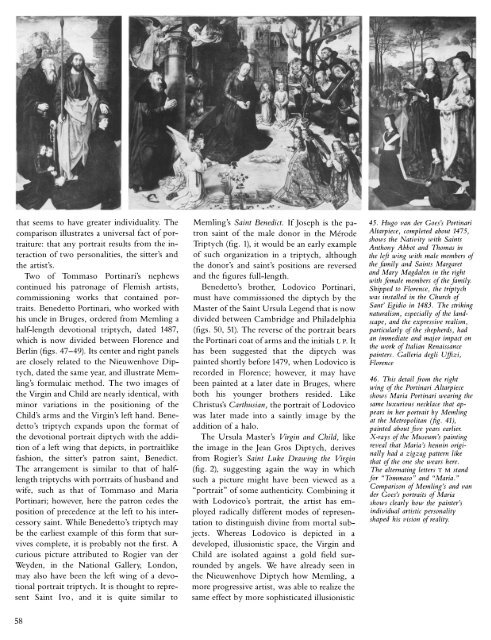Early Flemish Portraits 1425-1525: The Metropolitan Museum of Art ...
Early Flemish Portraits 1425-1525: The Metropolitan Museum of Art ...
Early Flemish Portraits 1425-1525: The Metropolitan Museum of Art ...
You also want an ePaper? Increase the reach of your titles
YUMPU automatically turns print PDFs into web optimized ePapers that Google loves.
that seems to have greater individuality. <strong>The</strong> Memling's<br />
comparison illustrates a universal fact <strong>of</strong> portraiture:<br />
that any portrait results from the interaction<br />
<strong>of</strong> two personalities, the sitter's and<br />
the artist's.<br />
Two <strong>of</strong> Tommaso Portinari's nephews<br />
continued his patronage <strong>of</strong> <strong>Flemish</strong> artists,<br />
commissioning works that contained portraits.<br />
Benedetto Portinari, who worked with<br />
his uncle in Bruges, ordered from Memling a<br />
half-length devotional triptych, dated 1487,<br />
which is now divided between Florence and<br />
Berlin (figs. 47-49). Its center and right panels<br />
are closely related to the Nieuwenhove Diptych,<br />
dated the same year, and illustrate Memling's<br />
formulaic method. <strong>The</strong> two images <strong>of</strong><br />
the Virgin and Child are nearly identical, with<br />
minor variations in the positioning <strong>of</strong> the<br />
Child's arms and the Virgin's left hand. Benedetto's<br />
triptych expands upon the format <strong>of</strong><br />
the devotional portrait diptych with the addition<br />
<strong>of</strong> a left wing that depicts, in portraitlike<br />
fashion, the sitter's patron saint, Benedict.<br />
<strong>The</strong> arrangement is similar to that <strong>of</strong> halflength<br />
triptychs with portraits <strong>of</strong> husband and<br />
wife, such as that <strong>of</strong> Tommaso and Maria<br />
Portinari; however, here the patron cedes the<br />
position <strong>of</strong> precedence at the left to his intercessory<br />
saint. While Benedetto's triptych may<br />
be the earliest example <strong>of</strong> this form that survives<br />
complete, it is probably not the first. A<br />
curious picture attributed to Rogier van der<br />
Weyden, in the National Gallery, London,<br />
may also have been the left wing <strong>of</strong> a devotional<br />
portrait triptych. It is thought to represent<br />
Saint Ivo, and it is quite similar to<br />
Saint Benedict. If Joseph is the patron<br />
saint <strong>of</strong> the male donor in the Merode<br />
Triptych (fig. 1), it would be an early example<br />
<strong>of</strong> such organization in a triptych, although<br />
the donor's and saint's positions are reversed<br />
and the figures full-length.<br />
Benedetto's brother, Lodovico Portinari,<br />
must have commissioned the diptych by the<br />
Master <strong>of</strong> the Saint Ursula Legend that is now<br />
divided between Cambridge and Philadelphia<br />
(figs. 50, 51). <strong>The</strong> reverse <strong>of</strong> the portrait bears<br />
the Portinari coat <strong>of</strong> arms and the initials L P. It<br />
has been suggested that the diptych was<br />
painted shortly before 1479, when Lodovico is<br />
recorded in Florence; however, it may have<br />
been painted at a later date in Bruges, where<br />
both his younger brothers resided. Like<br />
Christus's Carthusian, the portrait <strong>of</strong> Lodovico<br />
was later made into a saintly image by the<br />
addition <strong>of</strong> a halo.<br />
<strong>The</strong> Ursula Master's Virgin and Child, like<br />
the image in the Jean Gros Diptych, derives<br />
from Rogier's Saint Luke Drawing the Virgin<br />
(fig. 2), suggesting again the way in which<br />
such a picture might have been viewed as a<br />
"portrait" <strong>of</strong> some authenticity. Combining it<br />
with Lodovico's portrait, the artist has em-<br />
ployed radically different modes <strong>of</strong> representation<br />
to distinguish divine from mortal subjects.<br />
Whereas Lodovico is depicted in a<br />
developed, illusionistic space, the Virgin and<br />
Child are isolated against a gold field surrounded<br />
by angels. We have already seen in<br />
the Nieuwenhove Diptych how Memling, a<br />
more progressive artist, was able to realize the<br />
same effect by more sophisticated illusionistic<br />
45. Hugo van der Goes's Portinari<br />
Altarpiece, completed about 1475,<br />
shows the Nativity with Saints<br />
Anthony Abbot and Thomas in<br />
the left wing with male members <strong>of</strong><br />
the family and Saints Margaret<br />
and Mary Magdalen in the right<br />
with female members <strong>of</strong> the family.<br />
Shipped to Florence, the triptych<br />
was installed in the Church <strong>of</strong><br />
Sant' Egidio in 1483. <strong>The</strong> striking<br />
naturalism, especially <strong>of</strong> the landscape,<br />
and the expressive realism,<br />
particularly <strong>of</strong> the shepherds, had<br />
an immediate and major impact on<br />
the work <strong>of</strong> Italian Renaissance<br />
painters. Galleria degli Uffizi,<br />
Florence<br />
46. This detail from the right<br />
wing <strong>of</strong> the Portinari Altarpiece<br />
shows Maria Portinari wearing the<br />
same luxurious necklace that appears<br />
in her portrait by Memling<br />
at the <strong>Metropolitan</strong> (fig. 41),<br />
painted about five years earlier.<br />
X-rays <strong>of</strong> the <strong>Museum</strong>'s painting<br />
reveal that Maria's hennin originally<br />
had a zigzag pattern like<br />
that <strong>of</strong> the one she wears here.<br />
<strong>The</strong> alternating letters T M stand<br />
for "Tommaso" and "Maria."<br />
Comparison <strong>of</strong> Memling's and van<br />
der Goes's portraits <strong>of</strong> Maria<br />
shows clearly how the painter's<br />
individual artistic personality<br />
shaped his vision <strong>of</strong> reality.

















